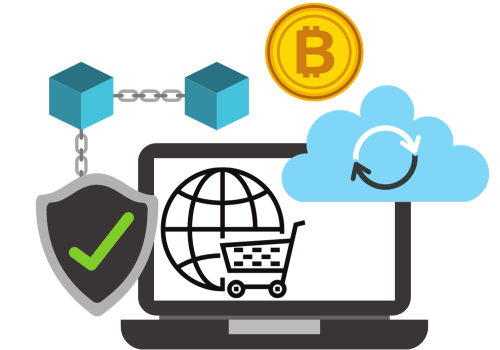Electronic commerce, or e-commerce, is the term for the online purchasing and selling of products and services. To carry out these transactions, data and money transfers are also involved. Though it can also apply to any type of web-facilitated business transaction, e-commerce is most commonly associated with the online sale of tangible goods.
Digital marketing plays a crucial role in e-commerce. It helps businesses reach, connect with, and influence customers online. It involves the use of digital channels like search engines, social media, email, and other websites to connect with current and prospective customers. In the context of e-commerce, digital marketing can help businesses increase brand awareness, drive traffic to their e-commerce site, and ultimately drive sales. Therefore, digital marketing is not just important but essential in the world of e-commerce.
E-commerce Landscape
The e-commerce landscape is continuously evolving, driven by technological advancements and changing consumer behaviours. In 2025, retail e-commerce sales were estimated to exceed $.7 trillion worldwide, and this figure is expected to grow exponentially, reaching about $8.1 trillion by 2026. The global e-commerce market’s sales reached USD 3.465 trillion last year, mainly due to increased consumer spending.
The e-commerce landscape is continuously evolving, driven by technological advancements and changing consumer behaviours. In 2023, retail e-commerce sales were estimated to exceed $8.7 trillion worldwide, and this figure is expected to grow exponentially, reaching about $10.1 trillion by 2027. The global e-commerce market’s sales reached USD 3.465 trillion last year, mainly due to increased consumer spending.
E-commerce is now in hyperdrive, accelerating the shift to online shopping. Many changes have occurred as a result of the growth of e-commerce, the majority of which are occurring behind the scenes. The global e-commerce market amounted to $48.7 trillion in 2023, with a growth rate of 27.6%. The growth is expected to slow down to 14.3% in 2025. With this growth rate, retail e-commerce sales worldwide are still expected to reach $10.1 trillion in 2027.
Major players in the e-commerce industry include Amazon, Alibaba, and JD.com. Amazon is the largest e-commerce company in the world by revenue, generating USD 280.5 billion in 2019 revenues. Alibaba and JD.com are Chinese e-commerce conglomerates that round out the top e-commerce companies by revenue. Other significant players include eBay, Apple, Walmart, and Rakuten.
The e-commerce landscape is rapidly growing and evolving, with major players leading the way. As technology continues to advance and consumer behaviours change, we can expect to see further growth and development in the e-commerce industry.
Emerging Trends in E-commerce
E-commerce is a dynamic field that’s constantly evolving. Here are some of the key trends that are shaping its future.
1. Mobile Commerce (M-commerce)
M-commerce refers to the use of mobile devices to conduct online transactions. It’s a trend that’s growing rapidly, thanks to the convenience it offers. With just a few taps on their smartphones, consumers can shop anytime, anywhere. Businesses are responding by optimising their websites for mobile use and developing apps to enhance the mobile shopping experience.
M-commerce is not just about convenience; it’s also about speed. With faster internet connections and more powerful mobile devices, consumers can now shop online faster than ever before. Moreover, businesses are leveraging mobile payment solutions to make transactions smoother and more secure.
2. Augmented Reality (AR) Shopping
AR shopping is another exciting trend in e-commerce. It allows consumers to visualise products in their own environment before making a purchase. For example, a furniture retailer might offer an AR app that lets customers see how a couch would look in their living room. This technology enhances the online shopping experience and can lead to more confident purchasing decisions.
AR shopping is not just about visualisation; it’s also about interaction. Consumers can interact with products in a virtual environment, giving them a better understanding of the product before they buy it. AR is also being used to provide virtual fitting rooms, allowing customers to try on clothes virtually before buying.
3. Voice Commerce
Voice commerce is the use of voice recognition technology to make online purchases. With the rise of smart speakers like Amazon’s Echo and Google Home, more and more consumers are using voice commands to shop online. This hands-free shopping method is convenient, fast, and user-friendly. Voice commerce is not just about convenience; it’s also about personalisation.
With voice recognition technology, businesses can personalise the shopping experience based on the consumer’s voice patterns and preferences. Moreover, voice commerce is expected to become more sophisticated with the advancement of AI technology.
4. Personalisation in E-commerce
Personalisation is all about providing a tailored shopping experience. Online retailers are using data analysis to understand their customers’ preferences and shopping habits. They can then personalise their websites, product recommendations, and marketing messages to match each customer’s interests. This can lead to increased customer satisfaction and loyalty.
Personalisation is not just about recommendations; it’s also about communication. Businesses can use personalised communication strategies to engage with their customers on a more personal level. Furthermore, personalisation is being taken to the next level with the use of AI and machine learning to predict customer behaviour and provide even more tailored experiences.
These emerging trends are transforming the landscape of e-commerce. They’re making online shopping more convenient, engaging, and personalised than ever before. As technology continues to evolve, we can expect to see even more innovative trends in the future. E-commerce has a bright and exciting future ahead of it.
Strategies for Digital Marketers
In the digital age, marketing strategies are constantly evolving. Here are some key strategies that digital marketers are using today.
A. Influencer Marketing
Influencer marketing is a strategy that involves partnering with influential people in your industry to promote your products or services. These influencers have a large following and can help increase brand awareness and drive sales. The key to successful influencer marketing is finding influencers who align with your brand values and have a genuine connection with their followers.
B. Social Media Integration

Social media integration is about more than just having a presence on social media platforms. It involves integrating your social media efforts with your overall marketing strategy. This means using social media to drive traffic to your website, promote your products, and engage with your audience. It also involves tracking your social media metrics to understand what’s working and what’s not.
C. User-Generated Content
User-generated content (UGC) is any content—text, videos, images, reviews, etc.—created by people rather than brands. Brands will often share UGC on their own social media accounts, websites, and other marketing channels. UGC is a powerful way to build community and authenticity around your brand. It shows that you value your customers’ voices and contributions.
D. Artificial Intelligence (AI) in Marketing

AI is becoming increasingly important in digital marketing. It can be used to analyse customer data, personalise marketing efforts, and improve customer service. For example, AI can be used to analyse customer behaviour and create personalised marketing messages that resonate with individual customers. AI can also be used in chatbots that can provide instant customer service.
These strategies are not only effective but also necessary in the current digital marketing landscape. By leveraging influencer marketing, integrating social media efforts, encouraging user-generated content, and utilising AI, digital marketers can create more effective and engaging marketing campaigns.
Challenges and Solutions in the Digital Landscape
Here are some of the key challenges and their potential solutions.
1. Security Concerns
In the digital world, security is a major concern. Cyberattacks can lead to financial losses, damage to a company’s reputation, and a loss of customer trust.
Solution: Businesses can mitigate security risks by implementing robust security measures such as firewalls, encryption, and two-factor authentication. Regular security audits and employee training can also help prevent security breaches.
2. Data Privacy
With the increasing amount of data being collected and stored, data privacy has become a significant issue. Consumers are becoming more aware of their data rights and are demanding greater control over their personal information.
Solution: Businesses can address data privacy concerns by being transparent about their data collection practices and giving customers control over their personal information. Implementing strong data protection measures and complying with data privacy laws can also help build trust with customers.
3. Competition
The digital landscape is highly competitive. Businesses are constantly vying for customers’ attention and loyalty.
Solution: To stand out from the competition, businesses need to offer unique value propositions. This could be superior products or services, exceptional customer service, or innovative marketing strategies. Regular market research can also help businesses stay ahead of industry trends and competitors.
4. Customer Trust
Building and maintaining customer trust is a challenge in the digital age. With the prevalence of online scams and data breaches, customers are becoming more cautious about who they do business with online.
Solution: Businesses can build customer trust by being transparent, delivering on their promises, and providing excellent customer service. Regular communication with customers and promptly addressing any issues can also help build and maintain trust.
Future Innovations in the Digital Landscape
The digital landscape is constantly evolving, with new technologies and practices emerging all the time. Here are some of the future innovations that are set to shape the industry:
A. Blockchain in E-Commerce:

Blockchain technology, best known for powering cryptocurrencies like Bitcoin, has the potential to revolutionise e-commerce. It offers a decentralised and secure way to record transactions, making it ideal for e-commerce.
Blockchain can enhance transparency and trust in e-commerce. For example, it can be used to track the journey of a product from the manufacturer to the consumer, ensuring authenticity and preventing fraud. It can also facilitate secure, peer-to-peer transactions, reducing the need for intermediaries like banks.
Moreover, blockchain can help protect consumer data. Unlike traditional databases, blockchain data is decentralised and encrypted, making it more secure.
B. Virtual Reality (VR) Shopping:
Virtual reality (VR) is set to transform the shopping experience. VR shopping allows consumers to immerse themselves in a virtual store, browse products as if they were physically there, and even try products before buying.
For example, a clothing retailer could create a virtual fitting room where customers can try on clothes virtually. This can enhance the online shopping experience, making it more interactive and engaging.
VR shopping can also provide businesses with valuable insights into consumer behaviour. By tracking how consumers interact with products in the virtual store, businesses can gain a better understanding of their preferences and shopping habits.
C. Sustainable E-commerce Practices:
Sustainability is becoming increasingly important in e-commerce. Consumers are becoming more conscious of the environmental impact of their purchases and are seeking out businesses that prioritise sustainability.
Sustainable e-commerce practices can range from using eco-friendly packaging to offering carbon-neutral delivery options. Businesses can also implement sustainable sourcing practices, ensuring that their products are produced in an environmentally and socially responsible manner. Moreover, businesses can use digital platforms to educate consumers about the importance of sustainability and how their purchases can make a difference.
These future innovations—blockchain in e-commerce, VR shopping, and sustainable e-commerce practices—are set to shape the digital landscape. They offer exciting opportunities for businesses to enhance the shopping experience, improve security, and promote sustainability.
Conclusion:
As the future of E-commerce unfolds, digital marketers play a pivotal role in navigating the evolving landscape. Adapting to emerging trends, implementing innovative strategies, and addressing challenges head-on will be the keys to success. The E-commerce journey continues to be an exciting adventure, with limitless opportunities for those who embrace change.
Let’s contact Gripas Marketing for any e-commerce help!
FAQs
How can digital marketers stay ahead in the competitive E-commerce industry?
Embrace innovation, analyse data trends, and foster authentic connections with the audience through personalised and engaging content.
What role does artificial intelligence play in E-commerce marketing strategies?
AI offers data-driven insights, enabling marketers to understand consumer behaviour, predict trends, automate processes, and optimise marketing campaigns.
How can E-commerce businesses ensure data privacy amid rising security concerns?
Prioritise robust encryption, transparent data policies, and user consent mechanisms to safeguard customer data and build trust.
Why is sustainable E-commerce gaining prominence, and how can marketers contribute?
With increased environmental awareness, consumers value sustainable practices. Marketers can align with eco-friendly initiatives, communicating the brand’s commitment to sustainability.
What is the significance of virtual reality (VR) in the future of E-commerce?
VR enhances the shopping experience by providing immersive, virtual exploration of products. Marketers should anticipate and leverage VR technologies for a competitive edge.



